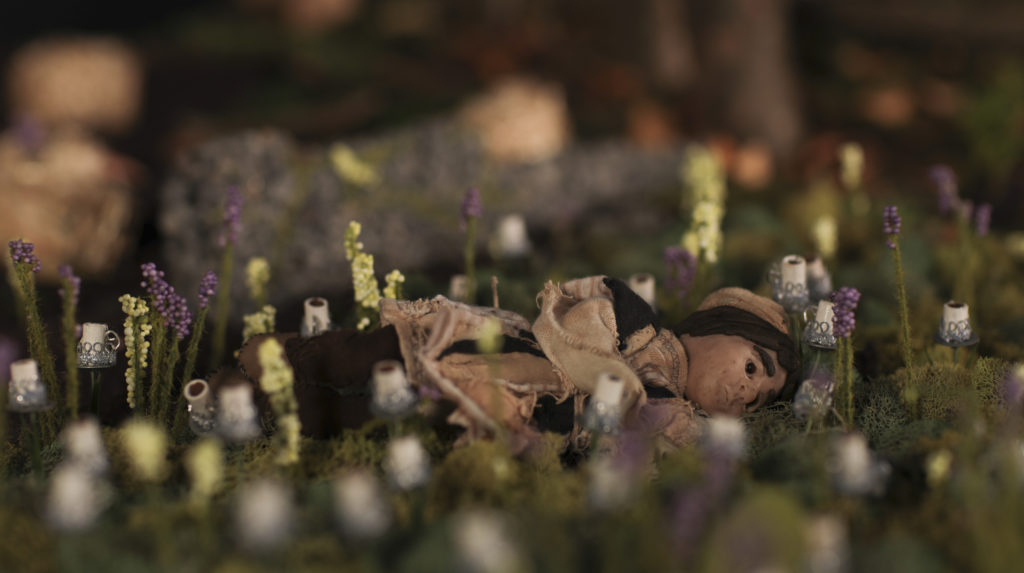A young boy wanders alone through a dark wilderness, lit only by the occasional ghostly flickers of fireflies. He passes through a field, a forest, and a cave before the fireflies lead him to a fortuitous, yet bittersweet, encounter.
[vimeo 232123569 w=640 h=360]
This is the deeply evocative setting in which we experience the new, stop-motion animated short film Under the Walnut Tree, directed and produced by Pennsylvania-based artist Leah Bedrosian Peterson.
The film’s plotline is inspired by the experiences of Armenian revolutionary and writer Shahan Natalie as a child during the Hamidian Massacres—the late 19th century precursors to the Armenian Genocide. Bedrosian, who chairs the Communication Department at Lycoming College, was moved by the traumas that Natalie went through as a child and recognized parallels between his experiences and current world events.
“As an artist you’re always looking for new inspiration and, for me, reading is a really big deal and plays a huge part in my inspiration for my work. So I just kept thinking about Natalie’s story and imagining his life and situation, and when I read about the circumstances [he went through] as a young boy and just thought about the world that we are in now and the circumstances that so many are dealing with, that’s really where the inspiration [for Under the Walnut Tree] started.”
While she wanted to honor her own Armenian heritage and educate viewers about the struggles that her ancestors went through, Bedrosian also wanted to make her film accessible to a broader audience—not just an Armenian one. In her quest for inspiration, she discovered a novel, What is the What: The Autobiography of Valentino Achak Deng by Dave Eggers, about one of “The Lost Boys”—or children soldiers—of the Second Sudanese Civil War (1983-2005). Bedrosian was struck by how similar Deng’s account was to Natalie’s and utilized it in shaping the story for her film.
“Using some of the power of that [Deng’s] narrative–the isolation, the loneliness, the almost on a cellular-genetic level attempt at survival yet you have no idea what the future holds for you, I used that…to then illustrate the story of Natalie throughout the film.”
The film also witnessed Bedrosian delve into new artistic territory. It was her first foray into the realm of stop-motion animation, but she didn’t embark on the film with this medium in mind. “My background is more in video art, so I just could not figure out how to make this film. What was I going to do? Go to an area that kind of looked like Armenia? How was I going to get to Armenia? Did I need to go to Turkey? So there were all these sort of mental roadblocks that were coming up for me when I was thinking about how to shoot [Under the Walnut Tree] with traditional film or even digital filmmaking. And then I thought, well, I’m going to make a sculpture of Natalie as a boy, so I started sculpting him and I thought, well, this would be kind of cool if he moved…and then all of the sudden all these pieces started clicking.”

Bedrosian enlisted the help of a former student, Gabriela Burch, who had worked in stop-motion, and, using Burch’s knowledge of the medium and of set design, began production on Under the Walnut Tree. She then recruited other students, colleagues, and friends to help over the two and a half years it took to realize the project. “There was no question about their interest in being involved in the film. I think that, the idea, again, of a story of a young child struggling to survive touches everyone regardless of their background and their own personal relationship to history.”
The film’s writer, Maria Hebert-Leiter, consulted Bedrosian about her family’s history when working on the film’s script. Bedrosian based the Natalie model’s face on her own son’s. She made sure to incorporate an Armenian carpet into the film as a nod to her great-great-uncle Harry Raphaelian, an expert on Oriental carpets, who was employed directly under Louis Comfort Tiffany as a colorist for Tiffany & Co.
Thus far, Under the Walnut Tree has won a number of awards, most notably, first place at the 2018 Florida Animation Festival. It also placed as a semi-finalist at the 2018 Animayo Animation Festival and at the 2018 Los Angeles CineFest. Recently, it was accepted to compete at the 21st Arpa International Film Festival in Hollywood, which will take place in November 2018. Bedrosian admits that she was caught off guard by the positive reception. “I think that every artist hopes that their work will be well-received and that the viewer or audience will connect with it in some way. My goal was to make a film that was both relevant and relatable yet had a direct reference to my personal history and the history of my people, the Armenian people. To know that so many have connected with the film and found value in the story is both humbling and thrilling.”
Bedrosian doesn’t know what her next project will be, although she would like to work on another stop-motion animation project. “I loved being able to utilize all my talents in one film…it’s just a matter of finding the right story.”
Author information
The post Bringing Old Stories to Life in Stop-Motion appeared first on The Armenian Weekly.
Source: Armenian Weekly
Link: Bringing Old Stories to Life in Stop-Motion
